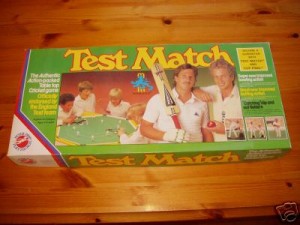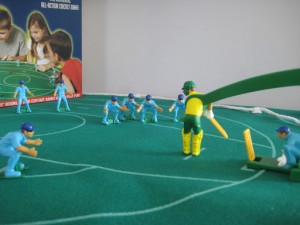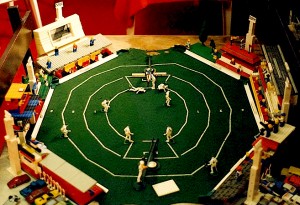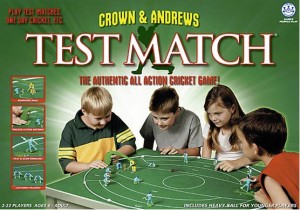
A gradual but inevitable descent into cricket-based loathing and bile.
In The Air! And Safe! And Out! #3: Test Match
Computers? Pah. Without getting all ‘four Yorkshiremen’ about things, some of us didn’t have such time-wasting, social life-wrecking and pointless electronic devices as young kids nowadays (jealous, me?). So these childhoods involved proper games, involving friends and family and proper human interaction.
Cricketing wise this can only mean one thing: Test Match. Whereas the computer games my colleagues are writing about in this series are far removed from reality, Test Match was authentic. It was also tangible; you could touch the shiny metal ball and use the mechanism to hit the ball yourself. It was real.
I mean, you’ve all seen proper cricketers bowl the ball down a chute and catches be awarded when the fielder’s stopped the ball between his legs haven’t you?
The first thing of note was the box that it – certainly the 1980s version – came in. This showed David Gower resting carefree on Ian Botham’s wide shoulders, lending the game the kind of authority that it deserved. His curls were rarely so golden, Botham’s ‘tache never again so quintessentially spiffing. The box also proudly announced that it was “The Authentic Action-packed Table top Cricket game” with the cheeky random captitalization that other games wouldn’t dare to try. Moreover, the game was “Officially endorsed by the England Test team.”
The internet shows that other, older-looking variants of the game were available, meaning it must have been around for longer than us. But seemingly the main components were constant.
In lieu of a proper board was a green fabric mat that was either laid out on a table top (sorry, Table top) or, if your mother had a precious dining table of the sort that would be easily wrecked and only saved by French Polishers, on the floor. Two contraptions were then placed at each end, namely a bowler and a batsman. The bowler was some kind of see-saw that sent the ball down a chute: the skill came from both the velocity at which the ball was rolled and the alignment of the chute. The batsman was afixed to a kind of rod; by using a lever the batsman’s torso and arms moved in a Victor Trumper-esque arc, whilst the legs showed the kind of non-existent footwork that makes Geoff Boycott wince. With clever timing, the miniature bat would strike the ball; without clever timing you ran the risk of being bowled.
The matting had concentric rings drawn in a dodecagonal shape, each ring offering a different number of runs. If my memory is correct, two areas were noted for a 6, at roughly deep mid wicket and deep extra cover. You see, not even Peter Pan Toys could devise a means to loft the ball over the boundary. The fielding side also had to place the fielders in the, erm, field. The game came with two sorts: the infielders, who crouched like Action Man going for a dump; and the outfielders, who were meant to stand up right, but, by having a centre of gravity somewhere around their nose, had a tendency to fall over flat on their face, much like Bobby Davro in the stocks. Each fielder had a band of semi-circular plastic between the legs in which he could ‘catch’ the ball.
With some (lots) of imagination, this simple set-up could allow two rivals to play long matches. Indeed, as one of the other boxes said, it could be played by 2-22 players. Now we know what went on in the dressing room in rain delays back in the 80s.
I daresay Test Match existed for years, but I associate it with the late 80s; the reason being that I can bizarrely and geekily still remember some of the scorecards that my brother and I would fill in. Invariably the matches were England vs. Rest of the World (Australia clearly not having enough decent players back then either). Amongst the players we’d select for the home team were Chris Broad, David Gower, Phil DeFreitas and Gladstone Small. Worryingly, I can even remember the batting line-up for the ROTW XI: Greenidge, Haynes, Boon, Richards, Border, Logie, Dujon, Marshall, McDermott. Okay, so only the top eight, but that is still an embarassing thing to recall.
No electronics, no bad music or dodgy graphics: just simple old-fashioned fun – and I bet there’s never been a computer game officially endorsed by the England Test team.





5 Comments
Post a Comment
1
51allout » No Such Thing As A Free Launch: Miles Jupp’s ‘Fibber in the Heat’
01 Dec 2012 10:01
[…] that Jupp fell in love with the sport as a child (happily for 51allout, with reference to both this game and that series). Then, following his post-Balamory purgatory of pantomime, he decided he wanted to […]
2
Nichael Bluth
13 Jul 2012 15:47
We should have more articles that subtly reference adverts for the Yellow Pages featuring Max Branning from Eastenders.
3
Arjun Miglani
13 Jul 2012 15:39
Third from left appears to be a young Nathan Bracken.
4
Matt Larnach
13 Jul 2012 15:24
Second from left on the cover of the Aussie version is a young Michael Clarke. I am sure of it.
5
James Knight
13 Jul 2012 15:07
I had this as well and I’m a 90’s kid. Might still have it somewhere, actually..